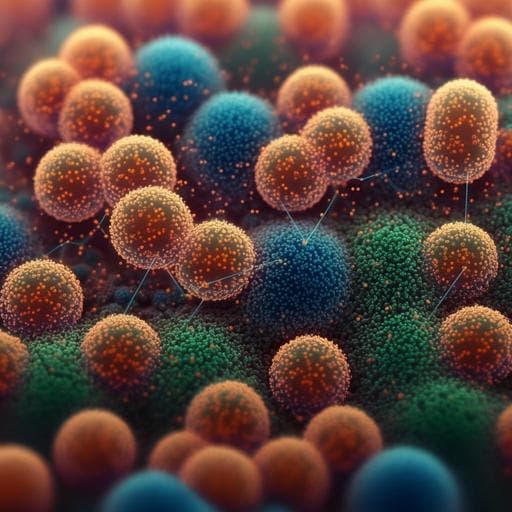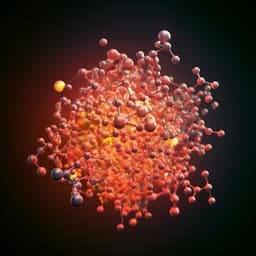
Medicine and Health
The interplay between dietary fatty acids and gut microbiota influences host metabolism and hepatic steatosis
M. Schoeler, S. Ellero-simatos, et al.
Explore how dietary lipids interact with gut microbiota to influence liver steatosis. Research by an accomplished team reveals that poorly absorbed long-chain saturated fatty acids can enhance metabolism and reduce liver fat, with significant microbial involvement. Discover the impact of polyunsaturated fatty acids and the importance of microbial diversity in metabolic health.
~3 min • Beginner • English
Introduction
Non-alcoholic fatty liver disease (NAFLD) is the most common chronic liver disease and a leading cause of liver-related mortality. Hepatic steatosis (the first step in NAFLD) is influenced by hepatic fatty acid uptake/disposal, de novo lipogenesis, and fatty acid oxidation. The composition of dietary fatty acids (saturated, monounsaturated, polyunsaturated) can modulate these processes. NAFLD is linked to an aberrant gut microbiota, with mouse and human studies indicating that microbiota can causally influence metabolic perturbations and hepatic fat accumulation. Prior work has shown diet–microbiota interactions (e.g., lard vs fish oil; milk fat) driving inflammation and steatosis, but how dietary lipid–microbiota interactions affect hepatic steatosis remains unclear. The aim of this study is to determine how dietary fatty acid composition affects the gut microbiota profile, microbiota-mediated metabolic regulation, and development of hepatic steatosis.
Literature Review
- Mouse studies demonstrate that NAFLD-associated gut microbiota can induce metabolic disturbances and increase hepatic fat in recipients; human microbiome signatures can discriminate NAFLD.
- Dietary lipids interact with gut microbiota to influence host physiology; prior findings include lard vs fish oil effects on adiposity/inflammation being microbiota-transmissible, and milk fat promoting pro-inflammatory responses and colitis, with milk fat diets inducing steatosis.
- Systematic reviews suggest high SFA intake reduces gut microbial diversity, while PUFA have minor effects; MUFA data are inconsistent. Dietary SFA raises liver fat more than PUFA/MUFA in interventions, whereas population data are limited.
- Mechanistically, n-3 PUFA regulate hepatic transcription factors to decrease lipogenesis; stearic acid (a long-chain SFA) has been associated with healthier lipid profiles and reduced fat accumulation and can modulate gut microbiota (e.g., increase Akkermansia) in liver disease models.
Methodology
Human cohort: 117 middle-aged participants (79 women, 35 men; 65 with obesity [BMI ≥30], 52 without) recruited in Girona, Spain (2016–2017). Exclusions: type 2 diabetes, recent infections, antimicrobial/PPI use, systemic inflammatory or psychiatric disorders, neurologic disease, language disorders, excessive alcohol. Diet assessed by validated FFQ (93 items). Participants were divided into tertiles of SFA, MUFA, and PUFA intake (n=39 per tertile). Outcomes: liver fat by MRI (mDixon protocol) and Fatty Liver Index (FLI), gut microbiota features (shotgun metagenomics). Confounders: age, BMI, sex, dietary fiber. Metagenomics: DNA extraction (QIAamp), library prep (Nextera Flex), sequencing (Illumina NextSeq 2x150), quality control (prinseq, FLASH), host read removal (bowtie2), taxonomic annotation (Kaiju), compositional analysis (clr after Bayesian-multiplicative imputation), robust linear regression (limma) adjusting for age, BMI, sex, fiber; multiple testing correction (SGoF), significance Padj<0.1.
Mouse diet study: Male C57BL/6 mice (SPF; 10/group, 2 cages/group; total ≈80) fed 8 isocaloric high-fat diets (42% kcal fat, equal fiber, 0.2% cholesterol) for 9 weeks: reference milk fat (MF), and diets A–G differing in fatty acid composition (A–C: high SFA but with less palmitic, more stearic and/or medium-chain SFA; D: lower SFA, higher MUFA; E–G: lower SFA, higher PUFA—n-3, n-6, or both). Body composition (MRI), glucose tolerance (IPGTT 2 g/kg), liver histology (H&E, steatosis scoring), hepatic triglycerides, fecal lipid species (free fatty acids, cholesterol, cholesteryl esters, triglycerides), hepatic transcriptomics (Agilent microarrays; limma with FDR≤0.05, fold-change>1.5), GO and TF enrichment (Revigo, Enrichr), sPLS regression (liver mRNA vs hepatic triglycerides). Cecal microbiota: 16S rRNA V4 sequencing (MiSeq 2x250), zOTU inference (UNOISE3), taxonomy (DADA2 with Silva v138), diversity (Faith’s PD, observed species), beta-diversity (Bray-Curtis, unweighted UniFrac; PCoA), variance analysis (adonis), differential abundance controlling for cage (metadeconfoundR; Wilcoxon + mixed-effects). SCFA quantification by GC-MS.
Multi-omics integration: DIABLO (mixOmics) integrating cecal zOTUs with host metabolic phenotypes and hepatic gene expression; rCCA for correlations between cecal/serum fatty acids and zOTUs or hepatic transcripts; network analysis of associations among fatty acids, taxa, diversity, and metabolic traits.
Microbiota-dependence and transfer: Germ-free mice fed MF or diet A for 9 weeks to test microbiota requirement for steatosis. Separate antibiotic-treated recipients (n≈15/group) on MF diet received cecal microbiota gavage twice weekly for 9 weeks from donors fed MF or diet A. Outcomes: weight, GTT, hepatic triglycerides and steatosis, fecal free fatty acid profiles, cecal microbiota composition and load, SCFA.
Bile acids: Vena porta bile acids measured (UPLC–MS/MS) in mice fed MF vs diet A and in microbiota transfer recipients. Expression of bile acid–responsive genes (ileal Fgf15, hepatic Shp) by qPCR.
Statistics and reproducibility: GraphPad Prism unless specified; no randomization; no a priori sample size calculation; lipid analyses and histology blinded; other experiments not blinded; adonis/ANOSIM permutations per protocol.
Key Findings
Human cohort:
- Gut microbiota composition clustered by SFA intake tertiles (PCA; p=0.005, PERMANOVA); MUFA near-significant (p=0.056); PUFA significant (p=0.02).
- Low SFA intake associated with higher alpha-diversity (Fisher’s alpha; observed species), independent of fiber; Shannon index not different.
- Multiple fiber-degrading Firmicutes/Spirochaetes (e.g., Acetivibrio cellulolyticus, [Clostridium stercorarium], [Clostridium] cellulosi) negatively associated with SFA intake; only 8 taxa positively associated with high SFA (including Proteobacteria and oral/skin bacteria). MUFA associations overlapped but were fewer/weaker; only two species associated with PUFA.
- Gut diversity (Fisher’s alpha, Shannon) negatively correlated with MRI liver fat and FLI in all individuals; in obese subset (n=85), SFA and PUFA intake positively correlated with FLI; Fisher’s alpha vs MRI and Shannon vs FLI remained significant.
Mouse diet study:
- Diets A–C (higher stearic and/or medium-chain SFA) led to leanness vs MF without reduced food intake; diets A and C showed increased fecal free fatty acids and degree of saturation; B increased fecal cholesteryl esters; triglycerides in feces unchanged.
- Hepatic fat: diets A, B, C, E, and G strongly reduced liver triglycerides and histological steatosis vs MF; diet A improved glucose tolerance.
- Hepatic transcriptomics: diets A/C upregulated cholesterol biosynthesis signatures (e.g., Hmgcs1 increased); diets E/G (PUFA-enriched) upregulated fatty acid metabolism and downregulated fatty acid biosynthesis signatures (e.g., Fasn decreased in E, F, G). sPLS separated E/G from MF along fatty acid/triglyceride biosynthesis axis and A/C/B from MF along sterol/cholesterol metabolism axis.
Gut microbiota (mice):
- Fat source explained 45% of microbiota variability (Bray-Curtis PCoA; R^2=0.45, p=0.0001). Most pairwise diet comparisons differed significantly (ANOSIM), with largest differences for C (R^2=0.87) and A (R^2=0.73) vs MF.
- Diets A/C reduced observed species and phylogenetic diversity without reducing bacterial load; increased Akkermansia and Bacteroides; decreased several butyrate producers (Roseburia, Oscillibacter, Anaerotruncus, Intestinimonas). Diet B decreased Lactobacillus/Bifidobacterium and increased butyrate producers (Alistipes, Butyricicoccaceae, Intestinimonas).
- Cecal SCFA in diet C: decreased butyrate, increased succinate, trend to increased propionate; similar trends in diet A.
- DIABLO: diets A/C drove integrated shifts linking zOTUs with host metabolic phenotypes and hepatic gene expression; Roseburia abundance negatively correlated with hepatic cholesterol biosynthesis gene sets (23-fold enrichment; p=0.0006 for GO steroid biosynthetic process).
Fatty acids–microbiota covariation:
- rCCA: 10-fold more correlations between cecal fatty acids and zOTUs than between serum fatty acids and zOTUs. Cecal long-chain SFA (C18:0–C24:0) mostly negatively correlated with many zOTUs; variation mainly driven by diets A/C.
- Network: cecal long-chain SFA negatively associated with diversity and with Roseburia, Anaerotruncus, Intestinimonas; positively associated with Akkermansia, Bacteroides, Christensenellaceae R7. Anaerotruncus associated with impaired glucose tolerance; Akkermansia and Christensenellaceae R7 associated with lower adiposity.
- Serum fatty acids showed stronger covariation with hepatic genes (10-fold vs cecal fatty acids), clustering into n-3 PUFA and n-6 PUFA/MUFA groups correlating with lipid metabolism gene sets; driven by diets E/G and to lesser extent A/C.
Microbiota dependence and transfer:
- Germ-free mice fed MF or diet A for 9 weeks did not develop steatosis, indicating microbiota is necessary for MF-induced perturbations.
- MF-fed recipients receiving diet A microbiota vs MF microbiota gained less weight, had improved glucose tolerance, lower steatosis and hepatic triglycerides; hepatic Hmgcr trended higher.
- Recipients of diet A microbiota had higher fecal saturated/unsaturated free fatty acid ratios; this ratio negatively correlated with body weight (R=-0.50, p=0.02); increased Lactobacillus and Acetatifactor; decreased Anaerotruncus and Akkermansia; no SCFA differences.
Bile acids and FXR signaling:
- Diet A vs MF: higher total vena porta bile acids and TβMCA; overall bile acid composition differed (p=0.02), with shifts in TBMCA, TwMCA, BMCA, ωMCA, TCA, CA; higher TBMCA/TωMCA and BMCA/ωMCA ratios; decreased ileal Fgf15 and hepatic Shp expression (FXR targets), consistent with FXR antagonism by TβMCA.
- Microbiota transfer: recipients of diet A microbiota showed altered bile acid composition (p=0.007), higher TBMCA/TωMCA and BMCA/ωMCA ratios, and decreased hepatic Shp; total bile acids not different; Fgf15 unchanged.
Discussion
The study shows dietary fatty acid composition shapes gut microbiota and influences hepatic steatosis via both microbiota-dependent and -independent mechanisms. In humans, SFA intake exerts a stronger effect on gut microbial diversity and taxa than MUFA or PUFA, independently of fiber intake, and lower diversity associates with higher liver fat. In mice, PUFA-enriched diets reduce steatosis and suppress de novo lipogenesis, likely via direct hepatic transcriptional modulation (e.g., n-3 PUFA effects on SREBP-1/HNF pathways) with minor microbiota changes. In contrast, diets enriched in poorly absorbed long-chain SFA (notably stearic acid from cocoa butter at sn-1/3 positions) reduce hepatic steatosis and adiposity, improve glucose tolerance, and substantially remodel the cecal microbiota and fermentation profiles. Elevated cecal long-chain SFA correlate with decreased diversity and specific shifts (increased Akkermansia/Bacteroides/Christensenellaceae R7; decreased Roseburia/Anaerotruncus/Intestinimonas), with network links to improved host metabolic features. Causality is supported by microbiota transfer: diet A–selected microbiota confers protection against MF-induced adiposity, glucose intolerance, and steatosis, increases fecal fatty acid saturation (consistent with microbial biohydrogenation capabilities of Lactobacillus), and modulates bile acid pools and FXR signaling (increased TβMCA, reduced Shp). Together, findings indicate that stearic acid–rich diets can beneficially alter gut–liver signaling via microbiota, fecal lipid saturation, and bile acid-mediated pathways to improve metabolic health.
Conclusion
This work demonstrates that defined variations in dietary fatty acid composition, independent of fiber intake, influence gut microbiota structure and function, hepatic metabolism, and liver steatosis. In humans, lower SFA intake associates with higher microbial diversity and a fiber-degrading microbiota, and diversity inversely correlates with liver fat. In mice, PUFA-enriched diets primarily reduce steatosis by suppressing hepatic lipogenesis with limited microbiota impact, whereas diets enriched in poorly absorbed long-chain SFA (stearic acid) reduce steatosis and adiposity through pronounced microbiota remodeling, increased fecal fatty acid saturation, and altered bile acid profiles that attenuate FXR signaling. Microbiota transfer confirms a causal role for diet-induced microbial communities in protecting against steatosis and metabolic impairment. Future research should identify specific microbial taxa/enzymes mediating biohydrogenation and bile acid transformations, define dose and positional specificity of stearic acid in different matrices, examine sex differences and long-term effects, and test translatability in controlled human interventions.
Limitations
- Human component is observational with a relatively modest sample size; dietary intake assessed by FFQ is subject to recall/reporting bias and residual confounding.
- Associations in humans cannot establish causality; MRI/FLI provide liver fat estimation but not full NAFLD spectrum.
- Mouse studies used only male C57BL/6 mice; results may not generalize to females, other strains, or species.
- Experiments were not randomized; no a priori power calculation; investigators were generally not blinded (except lipid analyses and histology), which may introduce bias.
- Microbiota transfer used antibiotic-treated mice (not germ-free) and repeated gavage; colonization efficiency and ecological stability may vary.
- Some diet comparisons had small n for specific assays (e.g., cecal/serum fatty acids, SCFA), and some fecal lipid values were missing due to limited material.
- Not all potential mechanisms (e.g., endotoxemia, host bile acid synthesis rates) were directly tested; one listed author affiliation (superscript 17) was not detailed in the provided affiliations list.
Related Publications
Explore these studies to deepen your understanding of the subject.







